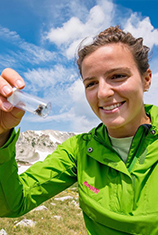

Abstract
Moose populations have declined at an alarming rate throughout North America. Building evidence has linked these declines to epizootics of winter ticks (Dermacentor albipictus) which have increased in frequency over the past 10 years. Winter ticks overlap with much of North America’s moose population, but greater than 30% of moose remain unexposed to winter ticks. Two possible reasons may explain winter tick range limits. The first is that winter ticks cannot withstand the dehydrating, cool conditions that characterize high latitude environments and therefore physiological thresholds limit the northward progression of winter ticks. Another explanation is that host dispersal limits winter tick ranges. If this is the case, winter ticks may persist in northern environments if infested animals interact with wildlife populations that are currently tick-free. The answer to these questions may directly inform wildlife management and conservation efforts by targeting financial resources. If winter ticks are physiologically limited, then conservation resources could be focused on currently infested moose populations; conserving uninfested habitats and mitigating the effects of climate change. If winter ticks are instead limited by host dispersal, conservation efforts could be focused on limiting the interactions between infested and uninfested wildlife populations, potentially through targeted management of migration corridors or increased hunting at winter tick range limits. We will use an integrative approach, combining methods from modelers, physiologists, landscape geneticists, and conservation biologists. We will measure winter tick physiological thresholds and population structuring and use mechanistic models to assess the future of winter tick epizootics and determine which populations of moose are most at risk. Our models may directly inform conservation efforts and provide a network of tick and moose biologists with data-driven recommendations for mitigating moose declines, understanding host-parasite interactions, and conserving North American wildlife.
